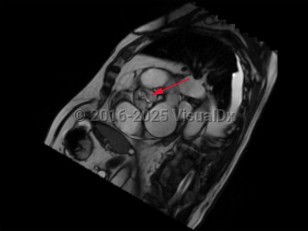Aortic stenosis
Alerts and Notices
Important News & Links
Synopsis

Aortic stenosis (AS) is the narrowing of left ventricular outflow through the aortic valve. It is the most prevalent cause of ventricular outflow obstruction, and it is increasing in prevalence as the population ages and life expectancy increases. While patients are generally asymptomatic in the presence of mild outflow obstruction, exertional dyspnea, chest discomfort, fatigue, dizziness, and syncope develop as the degree of obstruction progresses.
Contributing etiologies include calcification of the aortic valve cusps (most common in the elderly population), congenital abnormalities (ie, bicuspid aortic valve), rheumatic fever, chest radiotherapy, endocarditis, and alkaptonuria. Potential complications include heart failure, cardiac arrhythmias, infectious endocarditis, pulmonary hypertension, excessive bleeding, stroke, and other embolic events.
There is no known medical therapy available to delay progression of AS. Patients should be monitored carefully with serial clinical evaluations and echocardiography in order to determine if and when aortic valve replacement is needed, which may be performed by surgical aortic valve replacement or transcatheter aortic valve replacement (TAVR), also known as transcatheter aortic valve implantation (TAVI). Prolonged or intense physical activity and competitive sports should be avoided in patients with severe AS.
Contributing etiologies include calcification of the aortic valve cusps (most common in the elderly population), congenital abnormalities (ie, bicuspid aortic valve), rheumatic fever, chest radiotherapy, endocarditis, and alkaptonuria. Potential complications include heart failure, cardiac arrhythmias, infectious endocarditis, pulmonary hypertension, excessive bleeding, stroke, and other embolic events.
There is no known medical therapy available to delay progression of AS. Patients should be monitored carefully with serial clinical evaluations and echocardiography in order to determine if and when aortic valve replacement is needed, which may be performed by surgical aortic valve replacement or transcatheter aortic valve replacement (TAVR), also known as transcatheter aortic valve implantation (TAVI). Prolonged or intense physical activity and competitive sports should be avoided in patients with severe AS.
Codes
ICD10CM:
I06.0 – Rheumatic aortic stenosis
I35.0 – Nonrheumatic aortic (valve) stenosis
SNOMEDCT:
60573004 – Aortic valve stenosis
I06.0 – Rheumatic aortic stenosis
I35.0 – Nonrheumatic aortic (valve) stenosis
SNOMEDCT:
60573004 – Aortic valve stenosis
Look For
Subscription Required
Diagnostic Pearls
Subscription Required
Differential Diagnosis & Pitfalls

To perform a comparison, select diagnoses from the classic differential
Subscription Required
Best Tests
Subscription Required
Management Pearls
Subscription Required
Therapy
Subscription Required
References
Subscription Required
Last Reviewed:01/28/2021
Last Updated:05/15/2024
Last Updated:05/15/2024
Aortic stenosis

